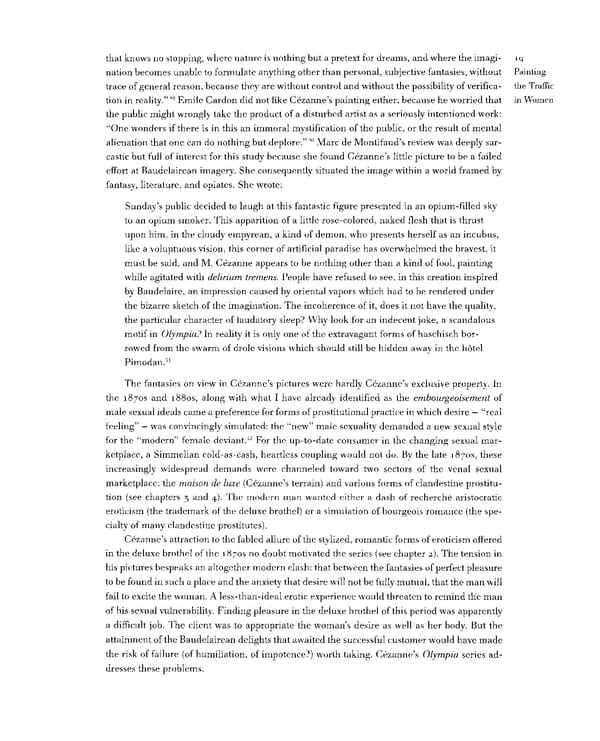that knows no stopping, where nature is nothing but a pretext for dreams, and where the imagi- !9 nation becomes unable to formulate anything other than personal, subjective fantasies, without Painting trace of general reason, because they are without control and without the possibility of verifica- the Traffic 49 in Women tion in reality." Emile Cardon did not like Cezanne's painting either, because he worried that the public might wrongly take the product of a disturbed artist as a seriously intentioned work: "One wonders if there is in this an immoral mystification of the public, or the result of mental 50 alienation that one can do nothing but deplore." Marc de Montifaud's review was deeply sar- castic but full of interest for this study because she found Cezanne's little picture to be a failed effort at Baudelairean imagery. She consequently situated the image within a world framed by fantasy, literature, and opiates. She wrote: Sunday's public decided to laugh at this fantastic figure presented in an opium-filled sky to an opium smoker. This apparition of a little rose-colored, naked flesh that is thrust upon him, in the cloudy empyrean, a kind of demon, who presents herself as an incubus, like a voluptuous vision, this corner of artificial paradise has overwhelmed the bravest, it must be said, and M. Cezanne appears to be nothing other than a kind of fool, painting while agitated with delirium tremens. People have refused to see, in this creation inspired by Baudelaire, an impression caused by oriental vapors which had to be rendered under the bizarre sketch of the imagination. The incoherence of it, does it not have the quality, the particular character of laudatory sleep? Why look for an indecent joke, a scandalous motif in Olympiad In reality it is only one of the extravagant forms of haschisch bor- rowed from the swarm of drole visions which should still be hidden away in the hotel 51 Pimodan. The fantasies on view in Cezanne's pictures were hardly Cezanne's exclusive property. In the 18708 and i88os, along with what I have already identified as the embourgeoisement of male sexual ideals came a preference for forms of prostitutional practice in which desire — "real feeling" — was convincingly simulated: the "new" male sexuality demanded a new sexual style 52 for the "modern" female deviant. For the up-to-date consumer in the changing sexual mar- ketplace, a Simmelian cold-as-cash, heartless coupling would not do. By the late 18705, these increasingly widespread demands were channeled toward two sectors of the venal sexual marketplace: the maison de luxe (Cezanne's terrain) and various forms of clandestine prostitu- tion (see chapters 3 and 4). The modern man wanted either a dash of recherche aristocratic eroticism (the trademark of the deluxe brothel) or a simulation of bourgeois romance (the spe- cialty of many clandestine prostitutes). Cezanne's attraction to the fabled allure of the stylized, romantic forms of eroticism offered in the deluxe brothel of the 18705 no doubt motivated the series (see chapter 2). The tension in his pictures bespeaks an altogether modern clash: that between the fantasies of perfect pleasure to be found in such a place and the anxiety that desire will not be fully mutual, that the man will fail to excite the woman. A less-than-ideal erotic experience would threaten to remind the man of his sexual vulnerability. Finding pleasure in the deluxe brothel of this period was apparently a difficult job. The client was to appropriate the woman's desire as well as her body. But the attainment of the Baudelairean delights that awaited the successful customer would have made the risk of failure (of humiliation, of impotence?) worth taking. Cezanne's Olympia series ad- dresses these problems.
 Prostitution & Impressionists Page 39 Page 41
Prostitution & Impressionists Page 39 Page 41